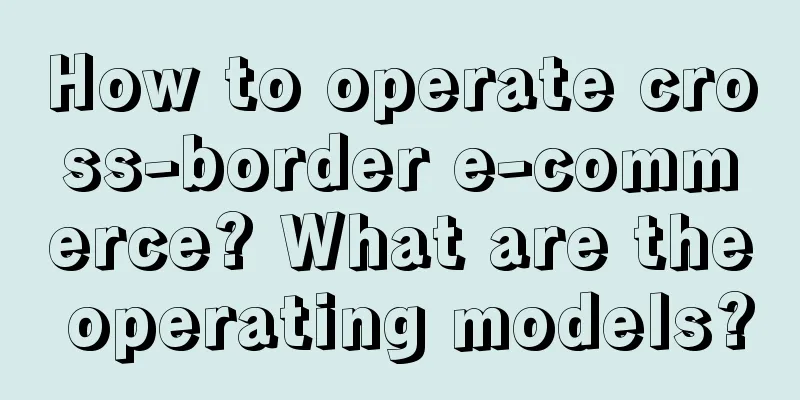How to operate cross-border e-commerce? What are the operating models?

|
With the progress of globalization, cross-border e-commerce has become a very popular industry. However, due to international differences and the fiercely competitive market environment, it is not easy to succeed in the field of cross-border e-commerce. So, how should cross-border e-commerce be operated? 1. How to operate cross-border e-commerce? First of all, building a strong supply chain is the key to the success of cross-border e-commerce. An efficient supply chain can ensure the timely delivery of goods and provide stable product quality. To this end, cross-border e-commerce needs to cooperate with high-quality suppliers and ensure the safe transportation of goods. Secondly, it is also very important to understand the culture and consumption habits of the target market. Different countries and regions have their own unique cultural backgrounds and shopping habits. Cross-border e-commerce should adjust product design and promotion strategies according to the needs of the target market to better meet the needs of consumers. In addition, a good brand image and reputation are crucial to the success of cross-border e-commerce. In a highly competitive market, having a trustworthy and recognized brand is the key to attracting consumers. Cross-border e-commerce should focus on brand publicity and promotion to enhance brand awareness and reputation. Finally, multi-channel sales and marketing strategies are also one of the elements of successful cross-border e-commerce operations. In addition to their own websites and online markets, cross-border e-commerce can also conduct sales and promotion through social media platforms, offline physical stores and other channels. At the same time, cross-border e-commerce can also use data analysis and market research to understand consumer needs and behaviors, so as to develop more effective marketing strategies. 2. What are the operating models? In the field of cross-border e-commerce, there are many different operating models. The following will introduce several common cross-border e-commerce operating models. Self-operated model: cross-border e-commerce directly manages and operates its own supply chain, warehousing and logistics. The advantage of this model is that it can have better control over product quality and logistics efficiency, but it requires a large investment of funds and human resources. Platform model: Cross-border e-commerce can choose to open a store on a third-party platform for sales. The advantage of this model is that it can take advantage of the platform's user traffic and brand influence, but it requires paying a certain platform service fee. Purchasing agent model: Cross-border e-commerce can act as a purchasing agent to help consumers buy overseas goods. The advantage of this model is that it can provide a more convenient shopping method, but it needs to solve problems such as product authenticity and after-sales service. Warehousing model: Cross-border e-commerce can choose to establish its own warehousing and distribution centers in the target market to provide faster and more reliable logistics services. The advantage of this model is that it can improve logistics efficiency and reduce transportation costs, but it requires a large investment of funds and resources. The success of cross-border e-commerce is inseparable from a strong supply chain, understanding the culture and consumption habits of the target market, a good brand image and reputation, and multi-channel sales and marketing strategies. The success of cross-border e-commerce operations requires the comprehensive use of these elements and the continuous optimization and adjustment of strategies to adapt to the ever-changing market environment. Recommended reading: Which platform should I choose for my personal cross-border e-commerce business? What are the requirements for entry? How much does it cost for personal cross-border e-commerce? Do I need a deposit? Can cross-border e-commerce personal trademarks be registered? What are the regulations? |
<<: How to increase the number of cross-border e-commerce visitors? How to increase traffic?
Recommend
KFC plays "price temptation" on Crazy Thursday: The truth behind the anchoring effect
It seems that it is not unfamiliar for brands to u...
Co-creation 4.1 - Clearing the fog of "consumption": the fourth consumer era and the rise of sharing consciousness
The consumption era and sharing consciousness are ...
What is the difference between thc fees and dock fees?
If domestic merchants want to sell products overse...
We talked to more than 10 brand owners about why it is difficult to plant grass on Xiaohongshu
Xiaohongshu has undergone a series of organization...
How do Chinese sellers join Jumia? What are the requirements?
Now the jumia platform has begun to attract the at...
6 steps to teach you how to activate a "dead" group in your private domain!
This article analyzes in detail how to reactivate ...
When using TikTok, don’t get these 8 types of influencers wrong!
This article proposes 8 types of personalities who...
Brand differentiation and establishment
In this article, the author starts with the origin...
With over 7 million paying members and annual GMV exceeding 1 billion, how did Youjian open 1,500 stores in the private domain?
With the development of the appearance economy, th...
How do I apply for a Wanlihui payment account? What are Wanlihui's fee standards?
As a cross-border payment service, Wanlihui has at...
WeChat Store is online. It’s time to re-understand WeChat e-commerce
The launch of WeChat Stores marks a key step in th...
Can I apply for early payment from Amazon? How long does it usually take to get the payment back?
Just like the rules of Taobao platform, the money ...
How does Wish prevent association? How do I set up association?
As a world-renowned e-commerce platform, Wish atta...
When they started using Xiaohongshu, I felt that Baidu’s winter was coming.
Is Xiaohongshu following Baidu's lead? Ask Xia...
Xiaohongshu's local life is still playing with the ticket period
At present, the popularity of group buying has not...









